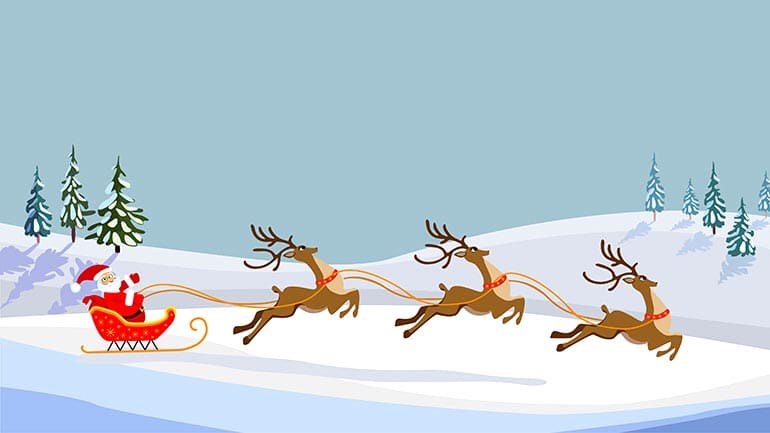With Christmas around the corner, this is to engage in some festive linguistics and investigate the roots of some of our favourite Christmas words. We hope this little glossary is helpful in understanding the background behind the terminology.
Advent – from the Latin adventus meaning ‘coming’, is the time when Christians prepare to celebrate the birth of Christ. Advent calendars have their origins in the German Lutherans, who would mark each day leading up to Christmas by drawing a chalk line on the door, hanging a picture, or lighting a candle.
 Bauble – The word ‘bauble’ may refer to the combination of two words: the Old French ‘baubel’ (a child’s toy) and the Old English ‘babyll’ (something that swings). In Old English, it was especially used to designate the mock symbol of office carried by a court jester, which is how it came to describe anything trivial or worthless. It is used to name the Christmas tree ornament since 1847.
Bauble – The word ‘bauble’ may refer to the combination of two words: the Old French ‘baubel’ (a child’s toy) and the Old English ‘babyll’ (something that swings). In Old English, it was especially used to designate the mock symbol of office carried by a court jester, which is how it came to describe anything trivial or worthless. It is used to name the Christmas tree ornament since 1847.
Christmas carols – are pretty much the only type of carols now, but there used to be others too. Originally they were religious songs, often for dancing; in the UK, such Catholic frippery was frowned on after the Reformation. ‘Carol’ comes from the French carole, meaning circle dance. (As a given name, ‘Carol’ is a female equivalent for ‘Carl’ or ‘Charles’ – nothing to do with music or dance.)
Gingerbread – Where did the bread come from in gingerbread? The word originates in the Latin ‘gingimbratus’ (preserved ginger), from ‘gingiber’ (ginger). It is thought that due to the intrusive ‘r’, the third syllable was confused with bread, which is how English acquired the term ‘gingerbread’ – through misunderstanding actually. Did you know that ‘gingerbread’ also refers to a flamboyant Victorian-era architectural style?
Mince pies – were originally pies made with minced meat, with fruit and spices added to the meat as a preservative. The meat gradually disappeared over time, leaving us with today’s meatless descendants. In Scotland, however, a mince pie is still a pie made with meat – so the seasonal fruit version is, sensibly, called a ‘Christmas pie’.
Mistletoe – The etymology of the word behind the lovely tradition of kissing under a mistletoe may surprise you, as it’s not quite as lovely and heart-warming as the tradition itself. The word comes from the Old English ‘misteltan’, composed of ‘mistel’ (dung) and ‘tan’ (twigs) – basically, “dung on a twig”. The plant was so named because it was found that mistletoe is fertilised by bird droppings. What’s more, most types of mistletoe are actually parasites; they cannot sustain themselves only on photosynthesis, so they seep nutrients from the tree that they’re growing on.
Noël – or ‘Nowell’ in English, is simply the French word for ‘Christmas’ and means exactly the same as a first name – hence its popularity for babies born on or near Christmas Day. It’s originally derived from natalis – Latin for ‘birth’ or ‘nativity’.
Reindeer – The first part, ‘rein’, stems from the Old Norse ‘hreinn’, which designates the animal itself and has Indo-European roots that refer to “the horned animal”. ‘Deer’ is likely to come from the Old Norse ‘dýr’, meaning animal. Speaking of reindeer, here’s a linguistic curiosity: The Finnish language has a word for the distance that a reindeer can travel before needing to urinate – ‘poronkusema’, literally ‘reindeer’s piss’.

Santa Claus – The name comes from the Dutch Sinterklaas, or Saint Nicholas. Being a saint, he was depicted wearing bishop’s robes until the nineteenth century, when US artists rebranded him in red ‘n’ white. (It’s possible that he has pre-Christian roots too, since there are parallels with the Norse god Odin.) Santa is actually a different person from Father Christmas, who traditionally typified good cheer but did not bring any gifts – but the two have merged over time.
Stuffing – The first mentions of ‘stuffing’ were in a Roman cookbook, which included a recipe for stuffed dormouse. The seasonal ‘ten-bird roast’ involves stuffing a large turkey with a goose, duck, mallard, guinea fowl, chicken, pheasant, partridge, pigeon and woodcock, along with some sausage and bacon for good measure. It can feed around 30 people – provided none of them have qualms about subjecting our fellow tenants on earth to such an appalling posthumous indignity.
Tinsel – was invented in 1610 and was originally made from shredded silver, which presumably made it the preserve of the very rich in decorating statues. Paper coated with aluminium was soon used instead, but proved highly flammable, and today’s tinsel is made from PVC. The term ‘tinsel’ comes from the Old French ‘estincelle’ (a spark) or ‘estinceler’ (to sparkle), rooted in the Latin ‘scintilla’, which also means spark. Tinsel is also a rare surname in Germany, the Czech Republic and Denmark.
Turkeys – were so named when Europeans first encountered them in America. Mistakenly identifying them as ‘Turkey fowl’ or guineafowl (which really did come from Turkey and the surrounding region), they soon shortened the name to just ‘turkey’, and it stuck. The correct collective noun is a ‘rafter’, although some people call a group of turkeys a ‘gobble’.
Yule – was originally a pagan fertility festival, celebrated by Germanic peoples, that was later absorbed into Christmas. The traditions of hanging mistletoe and burning a yule log seem to come from the same origin. No one really knows where the word comes from.
Xmas – The ‘X’ in Xmas, an abbreviation for Christmas, is derived from the Greek letter Chi, the first letter of the Greek word for ‘Christ’. The word ‘Xmas’ is snootily deprecated by most leading style guides, and sometimes criticised by those who see it as “taking the ‘Christ’ out of Christmas”.
The AVALON Linguistic team wishes all clients, readers and colleagues a very warm and cheerful Christmas.





